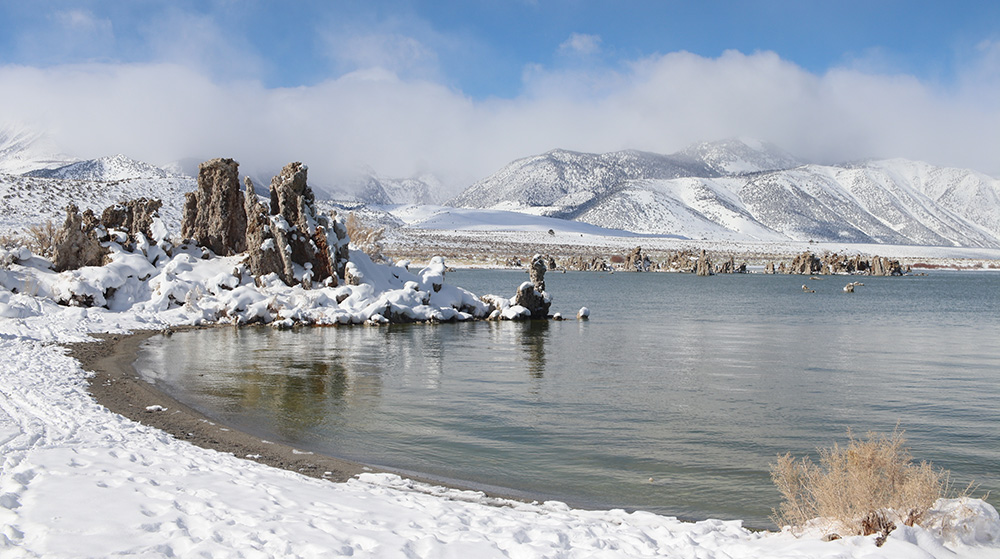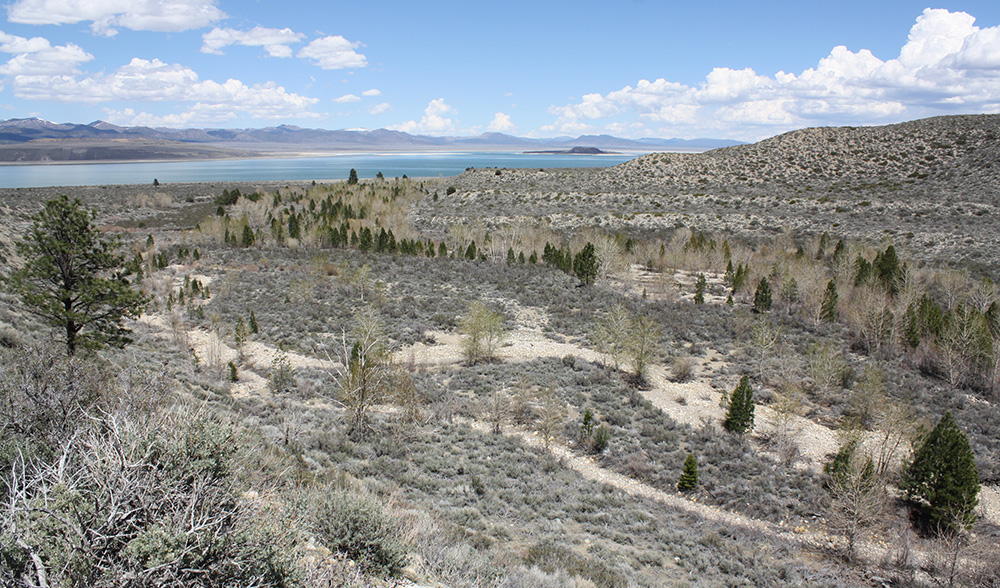
Today it is once again possible to see the sky out of the windows at the Mono Lake Committee office—instead of a wall of snow—but the wet and snowy 2018–19 winter will continue to affect Mono Lake and its tributary streams throughout the summer and well into fall.

Storms rolled into the Sierra this past winter and temperatures stayed cold, allowing for a large snow accumulation in Lee Vining and along the shore of Mono Lake. In February one noteworthy storm sequence dropped nearly four feet of snow in town and turned the entire Mono Basin into a snowfield. Another delivered blizzard conditions that closed the highway for days, leaving students from nearby June Lake stranded at school to sleep overnight at homes in Lee Vining.
By April 1, the winter snowpack measured 157% of average for the Mono Basin. It was an impressively wet winter, although other parts of the Sierra measured even higher. The winter snow is now melting, producing runoff that winds its way down Mono Lake’s tributary streams from April to August—this year’s Mono Basin runoff forecast is 145% of average.
Mono Lake on the rise
All this winter excitement is good news for Mono Lake. Ample snowmelt will more than replace annual evaporation from the lake’s surface and Mono will rise throughout the summer.
At more than 45,000 acres, Mono Lake is nearly twice the size of San Francisco—it takes a lot of water to raise the lake level. The Mono Lake Committee forecasts an impressive net rise in lake level of a foot and a half by next March. That gain, by volume, is over 60,000 acre-feet of water, which is enough to cover the state of Rhode Island an inch deep, or to fill the Rose Bowl to the top more than 235 times. Importantly, it is 15% of the rise needed to achieve the ecologically sustainable long-term level required by the California State Water Resources Control Board.
Wet years like this one perform the critical task of ratcheting the lake upward to higher levels. Average years, like winter 2017–2018, counteract evaporation and keep the lake stable. But it’s the wet years when lake rise happens—lifting the surface toward the required management level and restoring significant amounts of the 2.2 million acre-feet of water lost during decades of excessive water diversions.
Amidst a year of plenty, it is worth remembering that dry years happen. Although California’s recent five-year drought is fading into memory, Mono Lake is just now recovering from the seven-foot drop the 2012–2016 sequence of dry years caused. Had the drought not happened, the lake would be close to reaching its long-term management level. Next winter, the winter after, and the winters that follow will be critical factors in determining when Mono Lake will achieve that ecologically sound level, after which new export rules take effect to lock in those gains.
New temporary rules benefit stream restoration
This year’s ample runoff means Rush, Lee Vining, Parker, and Walker creeks will get the high flows that restore habitat by enhancing channel structure, scouring pools for fish, and spreading seeds and sediment across the floodplain to rebuild riparian forests. But will this water be delivered to maximum benefit? Thanks to recent action the answer is yes for 2019.
The Los Angeles Aqueduct impedes these tributaries, altering the timing and amount of water in 20 miles of stream that lie below the diversion dams. Extensive scientific work has informed a set of rules that maximizes the restoration benefits of the flows by guiding aqueduct operations throughout the year and ensuring that high flows are delivered in a natural pattern.
In 2013, after 15 years of intensive stream monitoring and three years of negotiations between the Committee, Los Angeles Department of Water & Power (DWP), and others, the Mono Basin Stream Restoration Agreement set forth a plan for implementation of the scientific recommendations. The new rules will ultimately become terms of DWP’s license to divert water from the Mono Basin. They include flow requirements, a feasible plan for the construction of a new outlet to overcome limitations of DWP’s 80-year-old Grant Dam, as well as monitoring and other important restoration matters.
However, the legal process of finalizing the license has been moving agonizingly slowly, and six years later the package of critical restoration measures in the Agreement has yet to be implemented.
The Committee has argued that the creeks should not have to wait any longer for the benefits of the new flow rules just because procedural matters are dragging on. Although high flows in Rush Creek can’t be achieved until the new outlet is constructed, existing aqueduct infrastructure can be used to deliver portions of the Rush Creek flow pattern, along with the new flow patterns for Lee Vining, Parker, and Walker creeks.
The State Water Board agreed.
A recently approved temporary license change puts the new streamflow requirements into action for 2019. That means decades of scientific study are now being put to work on a daily basis to restore the health of Mono’s long-suffering tributary streams.

Awaiting State Water Board action on DWP’s delay
Implementation of the full Stream Restoration Agreement remains a critical area of work for the Committee. DWP’s water license must be revised under the Agreement to permanently implement the new flow pattern, construct a new outlet at Grant Dam, and implement other important provisions.
The State Water Board is ready to take action and is waiting on just one thing: a supporting environmental document from DWP. Delivery of this document has been promised for years but has yet to happen. The State Water Board has expressed increasing impatience about the protracted delays. Committee staff and attorneys are pursuing multiple strategies to bring the license revision process to completion.
In the meantime, the temporary license change will make the most of the ample runoff. Despite lingering infrastructure limitations, Mono Basin streams will get the best restoration benefits possible this year.
This post was also published as an article in the Summer 2019 Mono Lake Newsletter (pages 3 & 4).
